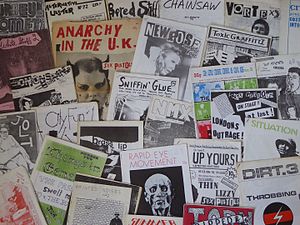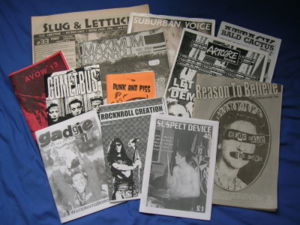Punk zine
This article has multiple issues.Please helpimprove itor discuss these issues on thetalk page.(Learn how and when to remove these template messages)
|

Apunk zine(orpunkzine) is azinerelated to thepunk subcultureandhardcore punkmusic genre. Often primitively or casually produced, they featurepunk literature,such as social commentary,punk poetry,news, gossip, music reviews and articles aboutpunk rockbands or regional punk scenes.
History
[edit]1970s: origins
[edit]Starting in the 1970s, theDIYaesthetic of the punk subculture created a thriving underground press. Amateur magazines related to punk were inspired by the rockfanzinesof the early 1970s, which were inspired by zines from the science fiction fan community. Perhaps the most influential of the fanzines to cross over fromscience fiction fandomto rock and, later, punk rock andnew wave musicwasGreg Shaw'sWho Put the Bomp,founded in 1970.
One of the earliest punk zines wasPunk,founded in New York City by John Holmstrom, Ged Dunn andLegs McNeil.Debuting in January 1976, the zine championed the early New York underground music scene and helped associate the word "punk" with these bands, most notably theRamones.Other early punkzines from the United States includedSearch & Destroy(laterREsearch),FlipsideandSlash.
An earlyUnited Kingdompunk zine wasSniffin' Glue,produced byMark Perry,who also founded the bandAlternative TV,in 1976. Perry produced the first photocopied issue ofSniffin' Gluein London after attending the Ramones concert on 4 July 1976 at the Roundhouse. Punk zines were produced in many European countries in subsequent years. The first Irish one was published in March 1977.[1]
In Australia in 1977, inspired bythe SaintsandRadio Birdman,Bruce MilneandClinton Walkerfused their respective first zinesPlastered PressandSuicide Alleyto launchPulp;Milne later went on to invent the cassette zine withFast Forward,in 1980. Another early publication wasSelf Abusefirst published in Sydney in December 1977.[2][3][4]
1980s
[edit]
The politically chargedMaximum RocknRolland the anarchistProfane Existencewere notable punkzines that were founded in the 1980s. By that time, most local punk scenes had at least one punkzine. The magazineFactsheet Fivechronicled thousands of underground publications and "zines" in the 1980s and 1990s.
In the 1980s, the punk self-publication scene was quickly expanding to include numerous different subcultures within the genre.[citation needed]For example, the birth of theQueercoremovement: inspired by the desire for social change, the subculture was represented by zines that sought to accept those within theLGBTcommunity who were also involved in punk and also had overwhelming themes of promoting individual rights.[5]The topics discussed in the issues often ignited forums and chatrooms where readers could share their opinions. This genre of zine was self-sustaining and produced in aDIYmanner.Queercoreis often accredited to a Toronto-based zine entitledJ.D.s,an abbreviation for "juvenile delinquents",[citation needed]created by H. Quinn and co-published with Bruce Wayne.H.Q.swas a cut-and-paste-style zine that featured manifestos and dialogue about identifying asqueerwithin the realms of the punk community.[6]Other zines that instigated this movement areChainsaw (punk zine),Outpunk,andHomocore.The queercore zines influenced theRiot Grrrlzines of the late 1980s and 1990s, as well.
Riot Grrrl zines
[edit]The "Riot Grrrl"movement emerged from the punk scene in the United States when women began to produce zines withfeministthemes.[7]The "riot grrrl" wave was influential for pinkzines as it called for women to publish and produce content in the male dominated culture.[8]Featuring political issues from a personal standpoint, the zines arose in popularity amongst the underground world of punk. The format of the "riot grrrl" zines was similar to that of queercore zines, in that they were cut and paste and xeroxed with many featuring collages.[9]Self-published punkzines from this era such asBikini Kill,Girl Germs,Le Tigre,andJigsawwere put out by members of riot grrrl bands who supported the notion of women learning to play music and feeling self-empowered.[10]Other apparent themes in this category of zine includeactivism,social change,sexuality,body image,and the discussion of controversial topics such asracismandabuse.
List of punk zines
[edit]- Absolutely Zippo
- Artcore
- Black Market Magazine
- Capitol Crisis
- Chainsaw
- Cometbus
- Damage
- Flipside
- Forced Exposure
- Gadgie
- Girl Germs
- HeartattaCk
- Homocore
- Jamming
- J.D.s
- Kill Your Pet Puppy
- Lights Go Out
- Lobotomy
- Love & Molotov Cocktails
- Matter
- Maximum RocknRoll
- New York Rocker
- No Cure
- Outpunk
- Ox-Fanzine
- Pork
- Profane Existence
- Punk Magazine
- Rancid News
- Rave On
- Razorcake
- RE/Search
- Ripped and Torn
- Slash
- Slug and Lettuce
- Sluggo!
- Sniffin' Glue
- Spuno
- Substitute
- Suburban Voice
- Suburban Rebels
- Take It
- TNSrecords Fanzine
- Touch and Go
- T.V.O.R.
References
[edit]- ^"Early Irish Fanzines".Loserdomzine. Archived fromthe originalon 28 September 2007.Retrieved15 August2007.
- ^Schaefer, Rene (18 September 2011)."Fast Forward: A Pre-Internet Story".Mess+Noise.Archived fromthe originalon 4 March 2016.
- ^"Fanzines (1970s)".Clinton Walker.Retrieved18 October2018.
- ^Popsike,Seldf Abuse,Australian Punk fanzine #3, April 1978 PSYCHO SURGEONS Filth X KBD, accessed 2021.01.22
- ^du Plessis, Michael; Chapman, Kathleen (February 1997). "Queercore: the Distinct Identities of Subculture".College Literature.24(1): 45–58.JSTOR25099625.
- ^Krishtalka, Sholem (20 September 2013)."Art essay: We are Queercore - Toronto Punks / a 'Porntastic Fantasy' Made Flesh".Xtra!.
- ^Brooks, Katherine (28 September 2013)."First Riot Grrrl Exhibition Explores the Lasting Impact of the Punk Feminist Movement".The Huffington Post.
- ^Meltzer, Marisa (2010).Girl Power: the Nineties Revolution in Music(1st ed.). New York: Faber and Faber.ISBN9780865479791.
- ^"A Brief History of Zines".Duke University Library.Archived fromthe originalon 9 October 2015.Retrieved23 November2015.
- ^Marcus, Sara (2010).Girls to the Front: the True Story of the Riot Grrrl Revolution(1st ed.). New York: HarperPerennial.ISBN9780061806360.
